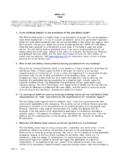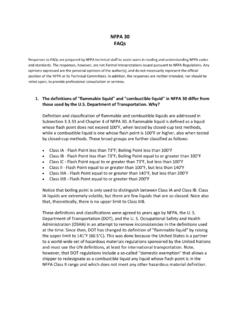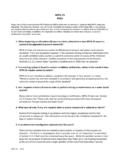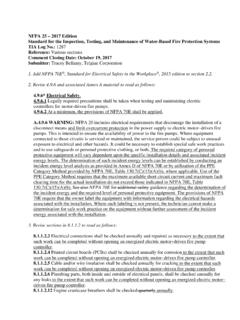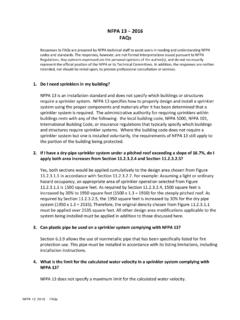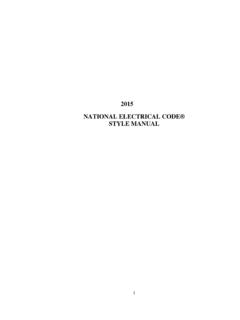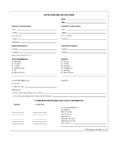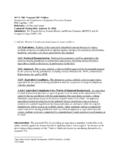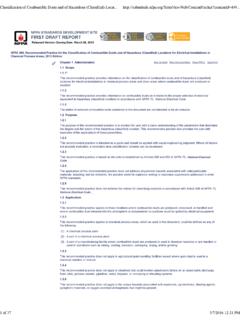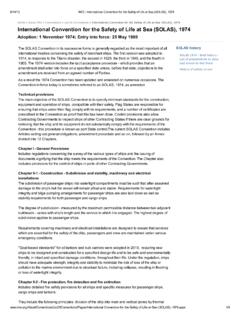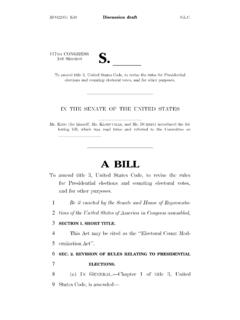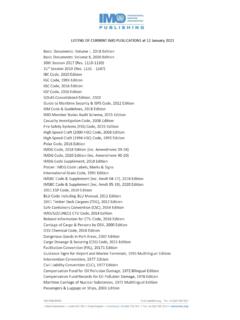Transcription of Modern vehicle fire hazards - NFPA
1 Modern vehicle hazards in Parking Structures and vehicle Carriers Final Report by: Haavard Boehmer, PE. Michael Klassen, , PE. Stephen Olenick, PE. Combustion Science & Engineering, Inc. Columbia, Maryland, USA. July 2020. 2020 fire Protection Research Foundation 1 Batterymarch Park, Quincy, MA 02169 | Web: | Email: Page ii . Foreword Vehicles have changed significantly over the years. Modern vehicles present new hazards , such as due to the incorporation of larger quantities of combustible materials ( fuels, plastics, synthetic materials, etc.) into their designs. As alternative fuel vehicles are popularized, concerns regarding their unique hazards , burn characteristics, and typical burn duration have been raised. Compared to older vehicles, Modern vehicles burn differently. Modern parking garages have optimized space requirements for vehicle parking and storage and often implement automated retrieval features and car stacking, which presents unique hazards as well.
2 Thus, it raises the question if the safety infrastructure of these parking structures and vehicle carriers ( maritime vessels) have kept pace. This project aimed to quantify the fire hazard of Modern vehicles in parking structures and vehicle carriers to provide guidance for the applicable technical committees. The fire Protection Research Foundation expresses gratitude to the report authors Haavard Boehmer, PE, Michael Klassen, , PE, and Steven Olenick, PE, who are with Combustion Science & Engineering, Inc. located in Columbia, MD, USA. The Research Foundation appreciates the guidance provided by the Project Technical Panelists, the funding provided by the project sponsors, and all others that contributed to this research effort. Thanks are also expressed to the National fire Protection Association ( nfpa ) for providing the project funding through the nfpa Annual Research Fund.
3 The content, opinions and conclusions contained in this report are solely those of the authors and do not necessarily represent the views of the fire Protection Research Foundation, nfpa , Technical Panel or Sponsors. The Foundation makes no guaranty or warranty as to the accuracy or completeness of any information published herein. About the fire Protection Research Foundation The fire Protection Research Foundation plans, manages, and communicates research on a broad range of fire safety issues in collaboration with scientists and laboratories around the world. The Foundation is an affiliate of nfpa . About the National fire Protection Association ( nfpa ). Founded in 1896, nfpa is a global, nonprofit organization devoted to eliminating death, injury, property and economic loss due to fire , electrical and related hazards . The association delivers information and knowledge through more than 300 consensus codes and standards, research, training, education, outreach and advocacy; and by partnering with others who share an interest in furthering the nfpa mission.
4 All nfpa codes and standards can be viewed online for free. nfpa 's membership totals more than 65,000 individuals around the world. Keywords: parking structures, parking garages, vehicles, vehicle carriers, ICE vehicles, electric vehicles, sprinkler criteria, nfpa 13, nfpa 88A, nfpa 301, vehicle hazards . Page iii . Report number: FPRF-2020-07. Project Manager: Victoria Hutchison Page iv . Project Technical Panel Kyle Bowker, NHTSA. Kevin Carr, nfpa , nfpa 88A Staff Liaison Michael Carsillo, International fire Marshals Association (IFMA), nfpa 88A Chairman Mark Cummings, fire Risk Management, nfpa 301 Chairman Benjamin Ditch, FM Global (alternate to Rich Wardak). Chad Duffy, nfpa , nfpa 13 Staff Liaison Tom Gardner, Harrington Group Kevin Hall, NFSA. Mark Hopkins, Terp Consulting Jason Huczek, Southwest Research Institute (SwRI). Stuart Lloyd, Zurich Tom Pedersen, IKEA.
5 Lawrence Russell, nfpa , nfpa 301 Staff Liaison Rich Wardak, FM Global Steve Wolin, Reliable Automatic Sprinkler Sponsor Representatives Casey Grant, SFPE Foundation Project Sponsors National fire Protection Association ( nfpa ). SFPE Foundation Page v . Modern vehicle fire hazards in Parking Garages and vehicle Carriers Final Report by: Haavard Boehmer, Michael Klassen, , Stephen Olenick, Combustion Science & Engineering, Inc. Columbia, Maryland, USA. July 2020. 2020 fire Protection Research Foundation One Batterymarch Park, Quincy, MA 02169, USA | Email: | Web: Modern vehicle hazards in Parking Garages and vehicle Carriers Executive Summary Fires in vehicles are not uncommon, but the majority of these occur along the road or after collision. vehicle fires in parking structures developing into large, out of control events are fairly rare, and civilian injuries in these types of incidents number fewer than two dozen annually in the USA.
6 However, fires in parking structures can lead to very large economic losses, as evidenced by recent fires at Liverpool's Echo Arena (UK) and at the Stavanger Airport (Norway). These incidents involved hundreds of automobiles and resulted in severe structural damage. Fires on marine vehicle carriers or ferries are extremely challenging due to the setting and can result in injury and loss of life to passengers and crew, as well as loss of the cargo and the vessel. Data on Modern vehicles imply there is a small, and shrinking, margin of error when a single vehicle fire can develop into a conflagration. It is important to understand the hazard posed by Modern vehicle fires and determine if current fire codes are mandating adequate fire protection requirements. This report details an analysis of the current scientific literature regarding the fire hazard Modern vehicles represent to parking garages and marine vessels.
7 The changes in vehicle and garage design have been documented, and the factors that most impact the fire development have been identified. Areas where current codes may be inadequate are presented and knowledge gaps and potential areas of research required to address the hazard are identified. There has been an increase in the fire hazard from changes in vehicle design and increased use of plastics and other combustible materials in vehicle construction. The increased plastic content of Modern vehicles manifests as faster flame spread within the vehicle , easier ignition and more rapid fire spread to neighboring vehicles. Modern parking garages tend to have narrower parking spaces than before, with increasing use of vertical stacker systems, leading to more densely packed fuel loads. The spread of fire between cars in a garage, especially from the initial to the second and third vehicles, is shown to be critical in determining the extent of the fire and the ability of the fire department to successfully control and extinguish it.
8 There is limited test data available on this spread between multiple vehicles, especially on newer cars. Some testing of multiple Modern vehicles has shown very rapid fire spread between vehicles in a parking garage configuration, on the order of 10-20 minutes. Based on the findings, test data from older vehicles (>15-20 years at the time of writing) should not be used as basis for development of codes and regulations. The evaluation of Modern vehicle fire hazards and current code requirements found that for enclosed parking garages and marine vessels the existing requirement for active protection systems appears adequate to control a vehicle fire until the fire department arrives, based on historical fires and laboratory testing. Open parking structures emerge as the main area of concern regarding fires in Modern vehicles. The lack of any requirements for active protection systems in fire codes, and trends in both vehicle and garage design suggest that large, devastating fires in these structures could become increasingly common.
9 Though the risk of civilian injuries will continue to remain low, these fires could cause extremely large property losses, business disruption, and adverse environmental impact. The current knowledge gaps focus on three areas; earlier detection and notification, viable sprinkler protection, and fire spread between vehicles. Focus of potential research in these three areas is proposed to better evaluate and analyze the threat of Modern vehicle fires in open parking garages. This understanding is also critical to determine the best approach to reduce the risk of catastrophic fires. Page 1. Modern vehicle hazards in Parking Garages and vehicle Carriers Table of Contents List of Figures .. 4. List of Tables .. 5. 1. Introduction .. 6. 2. Identification of the Problem .. 6. Notable vehicle fire Incidents .. 7. Storage and Transportation of Vehicles.
10 9. 3. Current Protection Requirements .. 9. nfpa 88A - vehicle Parking Structures ..10. Open and Enclosed Parking Garages ..10. Detection, Notification and Automatic Sprinkler Systems ..10. fire Resistance and Compartmentation ..11. International Parking Garage Codes ..11. Marine vehicle Carriers Codes ..12. nfpa 301 and 46 CFR ..13. IMO 4. Modern vehicle fire hazards ..14. vehicle Sizes and Use of Plastics ..15. Plastic Fuel Future Alternative Fuel Modern Parking Structures ..19. Building Design ..19. 5. Modern vehicle Hazard Assessment ..20. vehicle Design ..20. Heat Release Rate ..20. vehicle fire Tests ..21. Plastic fire Energy ..24. fire Spread ..25. BRE (UK) vehicle fire fire Resistance Rating Time-Temperature Requirements ..26. Plastic Fuel Tanks ..28. Battery Electric Vehicles ..29. Battery Energy Release ..29. Extinguishment ..31. Marine vehicle Transport Page 2.
